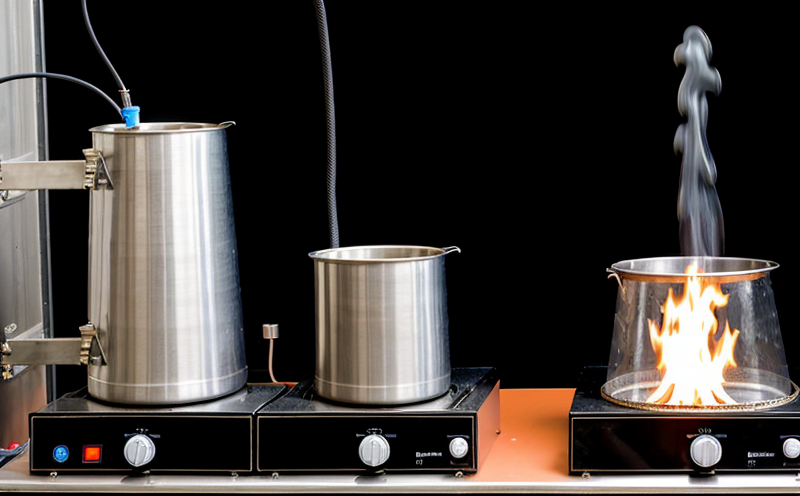Heat Release Testing of Rubber Materials
The heat release testing of rubber materials is an essential procedure in fire safety and product compliance. This service evaluates how much energy a material can potentially release upon combustion, providing critical insights for industries such as automotive, aerospace, and building construction. Understanding the heat release characteristics of rubber ensures that products meet stringent safety standards, enhancing overall fire resistance and reducing risks associated with flammability.
The process involves subjecting the rubber samples to controlled combustion conditions within a calorimeter. The calorimeter measures the amount of heat released during the burning process, quantifying it in terms of energy output per unit mass or area. This information is vital for assessing the fire hazard potential and ensuring that materials comply with international standards such as ISO 5660-2 and ASTM E1354.
Proper preparation of the specimen is crucial before testing. Samples must be cut into standard sizes, typically rectangular pieces, to ensure consistent measurement results. The thickness, surface area, and edge conditions all play significant roles in the test outcomes. Preheating or conditioning can also impact the test results, hence precise control over these parameters.
The calorimeter used for heat release testing operates on the principle of capturing heat released by burning materials under controlled conditions. It measures both the total energy released during combustion and the rate at which this energy is produced. This dual measurement approach provides comprehensive data that helps in understanding not only how much heat a material can release but also how quickly it does so.
The testing process typically involves igniting the specimen and monitoring its combustion behavior over time. Sensors within the calorimeter record various parameters like temperature, oxygen consumption, and carbon dioxide production. These data points are then processed to calculate key metrics such as heat of combustion, peak heat release rate (PHRR), and mass loss.
Understanding these metrics is crucial for material selection and design optimization in fire safety applications. For instance, higher PHRR values indicate faster rates of heat generation during combustion, which can be indicative of increased fire hazard. Conversely, materials with lower heat release properties are safer choices for use in high-risk environments.
In addition to these quantitative measures, visual observations such as flame spread and smoke density also contribute valuable information about the material’s performance under fire conditions. This holistic approach ensures that not only the energy output but also the combustion behavior is comprehensively evaluated.
The importance of accurate heat release testing cannot be overstated in ensuring product safety and compliance with regulations. By providing detailed insights into a material's combustibility, this service enables stakeholders to make informed decisions about material selection and design modifications.
Why It Matters
Heat release testing of rubber materials is fundamental for several reasons:
Ensures compliance with international standards such as ISO 5660-2, ASTM E1354, and EN 13826.
Promotes safer products by identifying potential fire hazards early in the development process.
Aids in optimizing material selection for specific applications where fire resistance is critical.
Supports R&D efforts to enhance product performance and safety features.
Facilitates procurement of materials that meet strict quality control criteria.
In essence, heat release testing plays a pivotal role in safeguarding lives and properties by ensuring that rubber products are inherently less prone to ignite or spread flames more rapidly under fire conditions.
Why Choose This Test
The test is highly accurate, providing precise measurements of heat release characteristics.
It offers a comprehensive evaluation of combustion behavior, including peak heat release rate and total energy released.
The service is conducted by experienced technicians using state-of-the-art equipment to ensure reliable results.
The data provided can be used to inform design changes that enhance fire resistance.
It supports compliance with international standards, ensuring products meet regulatory requirements.
The test is repeatable and reproducible, offering consistent results across multiple samples or testing sessions.
These advantages make heat release testing an indispensable tool for quality managers, compliance officers, R&D engineers, and procurement professionals working in the rubber industry.
Competitive Advantage and Market Impact
Incorporating robust heat release testing into your product development process can significantly enhance competitive advantage and market impact:
Enhanced Safety Reputation: Demonstrating a commitment to fire safety through rigorous testing can bolster your brand’s reputation, attracting more discerning customers.
Better Product Performance: Identifying and addressing potential fire hazards early in the development process ensures that final products perform better and are safer.
Increased Market Share: By meeting or exceeding stringent regulatory standards, you can capture a larger market share by offering products that are trusted for their safety and reliability.
Innovation Opportunities: The insights gained from heat release testing can inspire new product innovations aimed at improving fire resistance and performance.
Cost Savings: Early identification of issues through testing can prevent costly reworks or recalls later in the process.
Regulatory Compliance: Ensuring compliance with international standards can open up new markets for your products, especially in regions with strict fire safety regulations.





